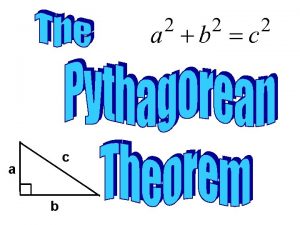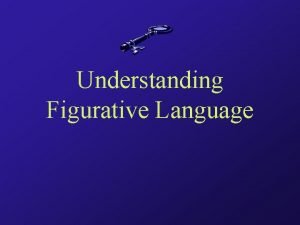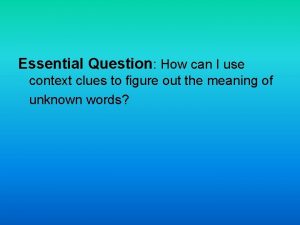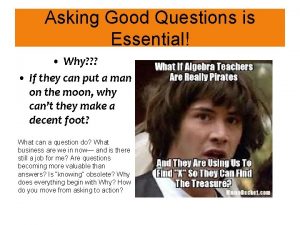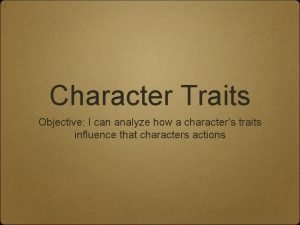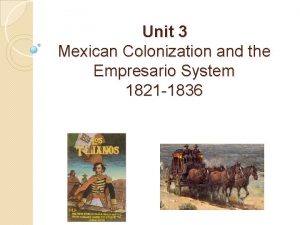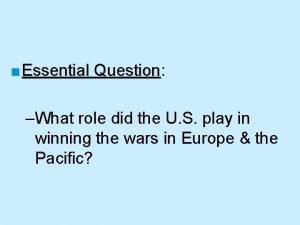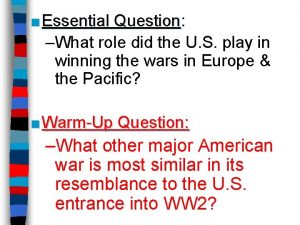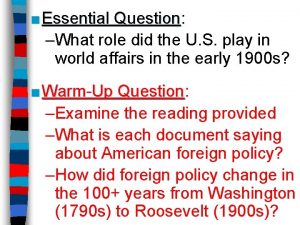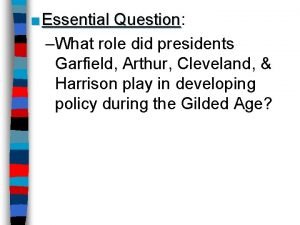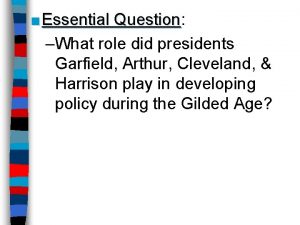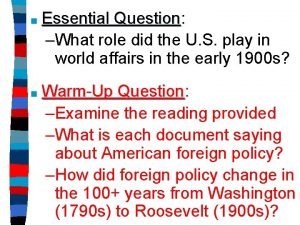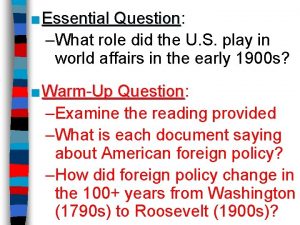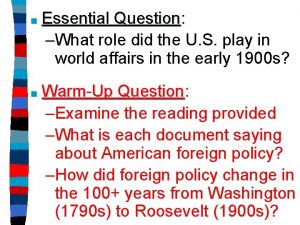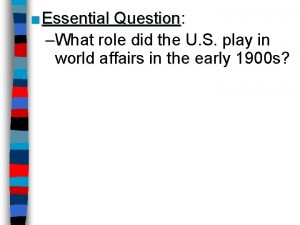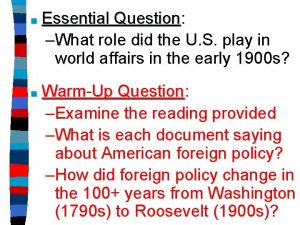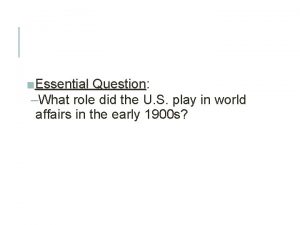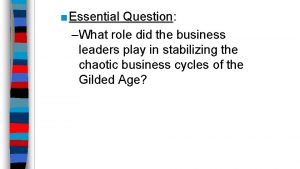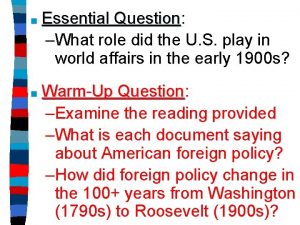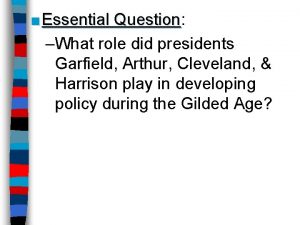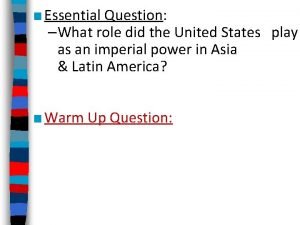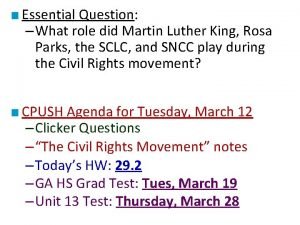Essential Question Question What role did the U




















- Slides: 20

■ Essential Question: Question –What role did the U. S. play in winning the wars in Europe & the Pacific? ■ Warm-Up Question: –What other major American war is most similar in its resemblance to the U. S. entrance into WW 2?

Germany, using When the U. S. entered WW 2 in late 1941, The Japanese blitzkrieg tactics, victory seemed remote dominated Asia, controlled almost all crippled of Europe the U. S. navy after the Pearl Harbor attack, Beginning in 1940, & seized most In 1941, Hitler broke England was wounded Western colonies in the from German attacks in the Pacific. Nazi-Soviet the Battle of Britain. Nonaggression Pact & marched into The German & Italian Russia. FDR & Churchill agreed that defeating Hitler was the top armies dominated Northern Africa, troops would be deployed to fight priority, but American threatened the Japan Suez at the same time. Canal & the oil fields in the Middle East. And over the next 2 years, the U. S. & the Allies began to win the wars in Europe & the Pacific

Europe 1941 -1943 The U. S. wanted to attack across Nazi-controlled France by 1943. Enland wanted to In 1942, U. S. -Anglo troops began campaign & Stalin was attack Italy from the Italian To win the European ANGRY bc he wanted a 2 front Northern Africa in campaign, 2 different war, dividing German forces. 1942. plans were proposed

The Allies began to win the Battle of the Atlantic (breaking German coded communications) in 1941 with Lend-Lease aid, but took control in 1943 with America’s entry into the war.

U. S. and British troops forced Germans into On Nov. 8, 1942, General Tunisia. Despite U. S. TURNING POINT: Forces Eisenhower loss landed on coast. Pass, led by British General at Kasserine of Morocco and Algeria. Montgomery stopped the Axis army was forced German forces led by to surrender in May 1943. Rommel (The Desert Fox. )The Allies finally defeated Germany at the Battle of El Alamein on Nov. 4, 1942 & then pushed the Axis Powers out of Africa. Britain & USA agreed to fight the Axis Powers in North Africa.

When Italians surrendered, Germans took over defense. Allies seized Rome in 1944, and in April 1945, the Germans finally surrendered. American & British troops invaded Italy. General Patton decided to take Southern Italy and Sicily in 1943. In 1945, Mussolini was captured & executed by the Italian resistance.

The Soviets defeated the German army atpoint the The Soviet victory at Stalingrad was a turning Battle of Stalingrad Meanwhile, the II Soviet armythe in World War because Russians beganin Feb. 1943. stopped the German attack at pushing towards Germany from the East by 1943. Moscow & Leningrad in 1942. The USSR was able to “free” Poland, Hungary, Romania.

Results of Stalingrad ■ Stalin began demanding the Allies invade Western Europe to relieve pressure on the Eastern front. ■ Russia developed perception that the West did not care about their suffering. This would help fuel the Cold War later. • U. S. lost 400, 000 in WWII • Russia lost 18 million. • Before the Battle of Stalingrad, nearly 500, 000 lived in the city; after battle, only 1, 500 still lived in the city. • More Russian forces died at Stalingrad than all U. S. forces combined during the entire war.

Tehran Conference, 1943 By agreeing to “Operation Overlord” (D- proposed a future United Nations ■FDR In Day), 1943, FDR, Churchill, Stalin met the Allies would divide the Axis dominated by “ 4 policemen” (USA, Britain, military across two fronts Iran for the firstimmediately of three China, in& Tehran, USSR) with power to “deal conferences: withwartime any sudden emergency which requires action” USSR –The USA, Britain, coordinated their war strategy –FDR & Churchill finally committed to Stalin’s demands to open a western front (D-Day) –Discussed plans to create a “general internat’l organization” to promote “peace & security” (UN)

Europe 1944 -1945 Operation Overlord (called D-Day) under Eisenhower in June 1944 was the largest land & sea attack in history. The Allies lost 10, 000 out of 150, 000 men. U. S. & British troops landed at 5 strategic points, pushed through France drove towards Germany. The long-awaited 2 nd front came on June 6, 1944 with D-Day.

The Normandy invasion was deadly, but the Allied victory created a Western Front… America: Story of Us: D-

This allowed the Allies to push towards Germany from the West. By fall 1944, Gen. Eisenhower and forces pushed Germans out of France. At the same time, the Soviet army pushed from the East. Reinforcements led by Patton solidified German defeat. Forced to fight a two-front war, Hitler ordered a massive surprise counter-attack in the Ardennes Forest at the Battle of the Bulge. (December 1944) 101 st Airborne stopped Germans. By March 1945, the Allies were fighting in Germany & pushing towards Berlin.

Results of Battle of the Bulge • This was the largest battle in Western Europe during WWII and the largest battle the U. S. fought in the War. • The U. S. lost 80, 000 and the Germans lost 100, 000. • This last attack by Hitler reduced the remaining strength of the German army, which significantly weakened the defense of Germany on both fronts.

Yalta Conference in February 1945 To recognize the independence ■ The “Big 3” met at Yalta to & sovereignty of nations in Eastern Europe discuss They also post-war Europe given agreed to the eminent defeat of Germany: occupy –Stalin up Eastern Germany afterrefused to give And they agreed the. Europe war. but he did to agree createto& “selfjoin a United Nations. determination” –Stalin agreed to send Soviet troops to the Pacific after the German surrender if the USSR could keep Manchuria


As the Allies pushed into Germany & Poland, troops discovered & liberated concentration & death camps. Liberation of Nazi Concentration Camps (2. 16)

Soon after the Yalta Conference in Feb 1945, FDR died…and Harry Truman became president

In late April 1945, the Allies broke through the Eastern & Western Fronts forcing both Italy & Germany to surrender

In April 1945, the Soviet army captured Berlin. On April 30, 1945, Hitler committed suicide. On May 9, 1945, the German government signed an unconditional surrender to the Allies. The world celebrated V-E Day (Victory in Europe).

The United States & the Holocaust ■ Examine the timeline “Stages of the Holocaust” & read “Response to the Holocaust from the U. S. ” ■ With a partner, answer the 3 discussion questions & prepare for a class discussion
 Plamatic acid
Plamatic acid Levels of questions examples
Levels of questions examples Dignity: the essential role it plays in resolving conflict
Dignity: the essential role it plays in resolving conflict Web role in azure
Web role in azure Role making role taking beispiele
Role making role taking beispiele Statuses and their related roles determine the structure
Statuses and their related roles determine the structure Essential questions about figurative language
Essential questions about figurative language Pythagorean theorem essential questions
Pythagorean theorem essential questions Essential question generator
Essential question generator Pythagorean theorem essential questions
Pythagorean theorem essential questions Essential question for figurative language
Essential question for figurative language Essential question about identity
Essential question about identity Use context clues in figuring out the meaning
Use context clues in figuring out the meaning What is the essential question in cornell notes
What is the essential question in cornell notes The art of asking essential questions
The art of asking essential questions Essential question for multiplication
Essential question for multiplication Essential question gif
Essential question gif Objective traits
Objective traits Cornell way
Cornell way Essential questions poetry
Essential questions poetry Empresario system
Empresario system









